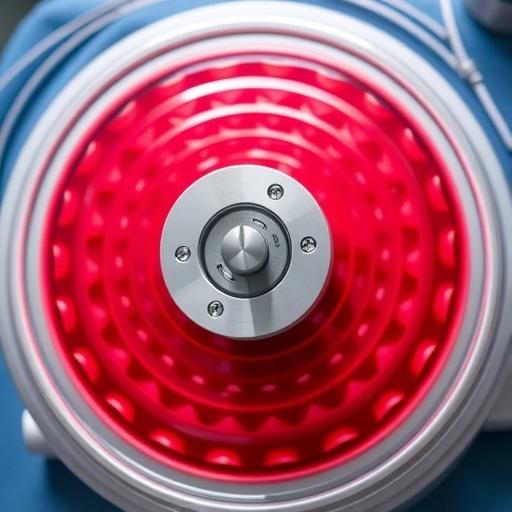In the relentless battle against vascular blockages caused by blood clots, medical science continually seeks more effective, less invasive solutions. Clots occluding arteries or veins trigger life-threatening emergencies including ischemic strokes, myocardial infarctions, and pulmonary embolisms. Mechanical thrombectomy, a minimally invasive procedure aimed at physically removing clots, has revolutionized treatment paradigms for these conditions. Despite impressive advances, current devices and techniques fail to achieve complete clot removal in up to 30% of patients, especially when confronted with large, dense, fibrin-rich thrombi. Moreover, conventional methods often induce clot fragmentation, risking distal embolization and worsened clinical outcomes.
A groundbreaking innovation now emerges from a team of researchers determined to surmount these persistent challenges. The milli-spinner thrombectomy device harnesses a novel mechanical principle that transforms the clot’s internal microarchitecture rather than relying solely on fragmentation or aspiration. This state-of-the-art tool employs rotational forces to induce compression and shear within the thrombus, mechanically compacting the fibrin matrix and facilitating the release of entrapped red blood cells. The result is a dramatic reduction in clot volume—up to 95%—enabling swifter and more complete removal through the vascular lumen.
This innovative approach contrasts sharply with traditional thrombectomy devices that typically retrieve clots by ensnaring or aspirating fragmented materials. Instead, the milli-spinner’s mechanism densifies the clot, effectively “shrinking” it in place before extraction. This mechanical densification is achieved through a carefully engineered spinning rotor that applies uniform shear forces on the clot while simultaneously compressing its structure. The dynamic interplay of these forces alters the clot’s biomechanical properties, transforming it from a bulky obstruction into a compact, manageable mass.
Extensive in vitro experimentation under physiologically relevant flow conditions within synthetic models of pulmonary and cerebral arteries has demonstrated the milli-spinner’s remarkable efficacy. These tests highlight the device’s ability to rapidly debulk clots, restore flow channels efficiently, and minimize distal emboli. The clot transformations observed indicate a fundamental physical alteration rather than mere disintegration, indicative of the device’s unique operational principle.
Beyond the benchtop, the milli-spinner’s performance was evaluated in vivo using swine models that emulate human vascular geometry and hemodynamics. These preclinical trials confirmed the device’s capacity for ultrafast clot removal while maintaining vessel integrity and preventing downstream occlusive events. The results underscore the potential translational impact for human patients, where timeliness and completeness of reperfusion critically shape clinical outcomes, particularly in ischemic stroke management.
Current thrombectomy technologies, such as aspiration catheters and stent retrievers, while effective in many scenarios, encounter limitations when addressing clots rich in fibrous networks. Such thrombi resist fragmentation and aspiration due to their dense, elastic nature. Attempts to forcibly disrupt these clots frequently result in embolic debris that complicates downstream perfusion. The milli-spinner circumvents these pitfalls by targeting the clot’s microstructural lattice, weakening it through mechanical densification rather than attempting to rip it apart.
This fundamental shift in mechanical thrombectomy strategy could exemplify a new therapeutic paradigm—modulating clot architecture in situ to facilitate removal rather than relying on brute-force extraction methods. The implications extend beyond cerebral embolism to peripheral vascular disease and pulmonary embolism, where current treatment failures pose significant morbidity and mortality risks worldwide.
In the device’s design, precise engineering ensured the rotor’s dimensions and spin rates deliver optimal shear without damaging delicate endothelium. Computational modeling played a critical role in optimizing parameters to balance maximal clot compression against minimal vessel trauma. The result is a robust yet gentle system capable of rapid thrombectomy without invoking additional injury cascades such as endothelial denudation or inflammatory responses.
Clinically, this technology promises to improve first-pass reperfusion success rates, a key predictor of patient recovery in acute ischemic stroke. By shrinking the clot volume and weakening its tensile integrity, the milli-spinner facilitates smoother extraction, reducing procedure time and associated risks. For patients whose survival and neurological outcomes hinge on rapid restoration of blood flow, such innovation could prove lifesaving.
The translational pathway ahead involves scaling these promising results in swine to human clinical trials. Regulatory considerations will focus on validating safety profiles, efficacy across diverse thrombus types, and integration with existing stroke intervention protocols. Additionally, the device’s compatibility with current endovascular platforms and ease of operator use will dictate its adoption in clinical practice.
Beyond the mechanical advancements, this approach invites further exploration into biomechanical modulation of pathological tissues. The milli-spinner represents an intersection between engineering ingenuity and clinical necessity, reminding us that innovation often arises from reimagining foundational concepts—in this case, how we physically interact with biological clots.
As the burden of thrombotic diseases continues to rise globally, devices like the milli-spinner offer refreshing hope. Its ability to overcome drawbacks of traditional thrombectomy methods not only enhances procedural success but may recalibrate treatment standards for acute vascular occlusions. This technology pushes the envelope in minimally invasive interventions, illustrating the profound potential of mechanical modulation at the microscale to drive macroscopic clinical benefits.
In summary, the milli-spinner thrombectomy device marks a paradigm shift by leveraging mechanical densification of clots to facilitate rapid, safe, and effective removal. Its success in laboratory and animal models foreshadows a future where catastrophic ischemic events might be mitigated more reliably, delivering improved outcomes for millions. Continued research and clinical development will determine whether this visionary device reshapes the landscape of vascular intervention.
Subject of Research: Mechanical thrombectomy innovations targeting clot microstructure to improve removal efficacy in ischemic and embolic vascular diseases.
Article Title: Milli-spinner thrombectomy
Article References:
Chang, Y., Wu, S., Li, Q. et al. Milli-spinner thrombectomy. Nature (2025). https://doi.org/10.1038/s41586-025-09049-0
Image Credits: AI Generated




